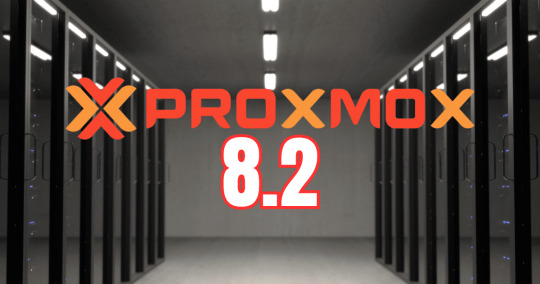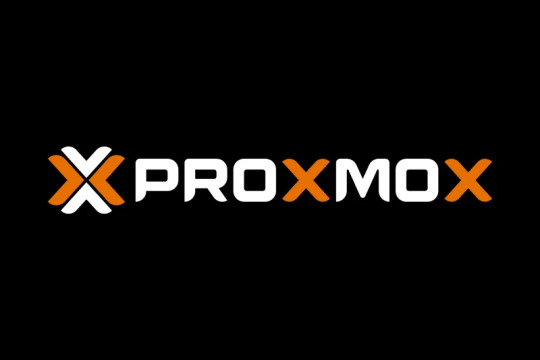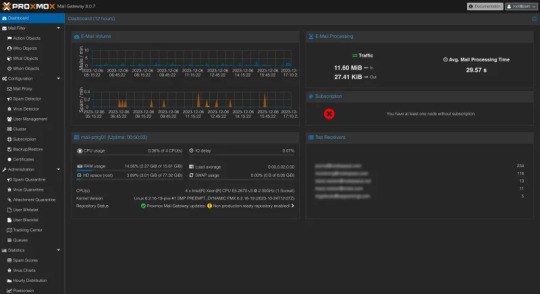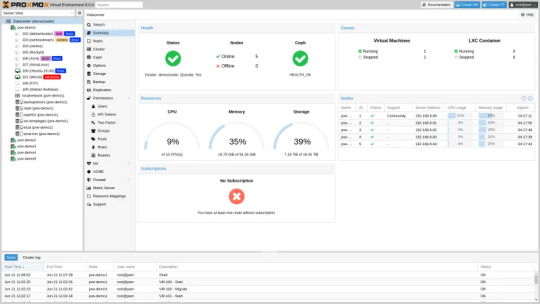#Proxmox Virtual Environment
Explore tagged Tumblr posts
Text
Resolve the Update Package Database failure on Proxmox VE
Proxmox Virtual Environment provides a complete open-source platform for enterprise virtualization. Its built-in web interface enables you to manage VMs and containers, configure software-defined storage and networking, set up high-availability clustering, and use multiple out-of-the-box tools all in a single solution. In this guide, we shall discuss the steps to resolve the Update Package…
#Change Proxmox Repository to Fix Update Error: How to resolve Update package database failure on Proxmox#Install Proxmox#proxmox#Proxmox Server#Proxmox Update Error#Proxmox VE#Proxmox Virtual Environment#Update Package Database
0 notes
Text
Proxmox GPU PassThrough: Step-by-step Guide
Proxmox GPU PassThrough: Step-by-step Guide #homelab #selfhosted #ProxmoxGPUPassthroughGuide #GPUPassthroughSetup #ProxmoxVirtualEnvironment #AMDResetBugSolution #NvidiaAMDGPUProxmox #ProxmoxHostConfiguration #PCIDevicepassthroughProxmox
One of the great things about running Proxmox in your home lab is the ability to use GPU passthrough. Home lab enthusiasts often use a repurposed gaming computer or workstation with a fairly powerful GPU installed. GPU passthrough provides many advantages when running a virtual machine with a GPU exposed directly to the operating system from the Proxmox host. Let’s look at GPU passthrough and how…

View On WordPress
#/etc/modprobe.d/blacklist.conf Editing#AMD Reset Bug Solution#GPU Passthrough Setup#IOMMU Support Proxmox#Nvidia & AMD GPU Proxmox#PCI Device IDs Proxmox#Proxmox GPU Passthrough Guide#Proxmox Host Configuration#Proxmox Virtual Environment#Proxmox VM GPU Assignment
0 notes
Text
Secure Proxmox VE Server With Let’s Encrypt SSL

Proxmox VE is a solution fit for adoption in an enterprise virtualization environment. It has a tight integration with KVM hypervisor and containers (LXC), software-defined storage and networking functionality all bundled in a single platform. The central user interface shipped in Proxmox VE has self-signed certificate, but with it you can run Virtual Machines, Containers, manage Networking and software-defined storage resources without touching command-line interface. In this article we shall discuss the process of securing your Proxmox server web console with Let’s Encrypt free SSL Certificate. For this guide, Proxmox VE should be on a public network with a valid […]
0 notes
Text
Proxmox VE 8.4 Özellikleri: Açık Kaynaklı Sanallaştırmada Yenilikler ve Performans Artışı
Merhaba, bu yazımda sizlere Proxmox sanallaştırma yazılımı 8.4 sürümünün özelliklerinden bahsedeceğim. Proxmox Virtual Environment (VE) 8.4, açık kaynaklı sanallaştırma ve konteyner yönetimi çözümünün en güncel sürümü olarak kullanıcılarla buluştu. Bu yeni sürüm, önceki versiyonların sağlam temellerini korurken, kullanıcıların sanallaştırma ve bulut altyapısı yönetim deneyimini büyük ölçüde…
#benefits of proxmox#best proxmox#cpu proxmox#current proxmox version#is proxmox a hypervisor#is proxmox kvm#proxmox 8 release date#proxmox 8.0
0 notes
Video
youtube
proxmox virtual environment Download and Setup- Install Multiple OS
0 notes
Text
Cloud Computing Solutions: Which Private Cloud Platform is Right for You?
If you’ve been navigating the world of IT or digital infrastructure, chances are you’ve come across the term cloud computing solutions more than once. From running websites and apps to storing sensitive data — everything is shifting to the cloud. But with so many options out there, how do you know which one fits your business needs best?
Let’s talk about it — especially if you're considering private or hybrid cloud setups.

Whether you’re an enterprise looking for better performance or a growing business wanting more control over your infrastructure, private cloud hosting might be your perfect match. In this post, we’ll break down some of the most powerful platforms out there, including VMware Cloud Hosting, Nutanix, H
yper-V, Proxmox, KVM, OpenStack, and OpenShift Private Cloud Hosting.
First Things First: What Are Cloud Computing Solutions?
In simple terms, cloud computing solutions provide you with access to computing resources like servers, storage, and software — but instead of managing physical hardware, you rent them virtually, usually on a pay-as-you-go model.
There are three main types of cloud environments:
Public Cloud – Shared resources with others (like Google Cloud or AWS)
Private Cloud – Resources are dedicated just to you
Hybrid Cloud – A mix of both, giving you flexibility
Private cloud platforms offer a high level of control, customization, and security — ideal for industries where uptime and data privacy are critical.
Let’s Dive Into the Top Private Cloud Hosting Platforms
1. VMware Cloud Hosting
VMware is a veteran in the cloud space. It allows you to replicate your on-premise data center environment in the cloud, so there’s no need to learn new tools. If you already use tools like vSphere or vSAN, VMware Cloud Hosting is a natural fit.
It’s highly scalable and secure — a great choice for businesses of any size that want cloud flexibility without completely overhauling their systems.
2. Nutanix Private Cloud Hosting
If you're looking for simplicity and power packed together, Nutanix Private Cloud Hosting might just be your best friend. Nutanix shines when it comes to user-friendly dashboards, automation, and managing hybrid environments. It's ideal for teams who want performance without spending hours managing infrastructure.
3. Hyper-V Private Cloud Hosting
For businesses using a lot of Microsoft products, Hyper-V Private Cloud Hosting makes perfect sense. Built by Microsoft, Hyper-V integrates smoothly with Windows Server and Microsoft System Center, making virtualization easy and reliable.
It's a go-to for companies already in the Microsoft ecosystem who want private cloud flexibility without leaving their comfort zone.
4. Proxmox Private Cloud Hosting
If you’re someone who appreciates open-source platforms, Proxmox Private Cloud Hosting might be right up your alley. It combines KVM virtualization and Linux containers (LXC) in one neat package.
Proxmox is lightweight, secure, and customizable. Plus, its web-based dashboard is super intuitive — making it a favorite among IT admins and developers alike.
5. KVM Private Cloud Hosting
KVM (Kernel-based Virtual Machine) is another open-source option that’s fast, reliable, and secure. It’s built into Linux, so if you’re already in the Linux world, it integrates seamlessly.
KVM Private Cloud Hosting is perfect for businesses that want a lightweight, customizable, and high-performing virtualization environment.
6. OpenStack Private Cloud Hosting
Need full control and want to scale massively? OpenStack Private Cloud Hosting is worth a look. It’s open-source, flexible, and designed for large-scale environments.
OpenStack works great for telecom, research institutions, or any organization that needs a lot of flexibility and power across private or public cloud deployments.
7. OpenShift Private Cloud Hosting
If you're building and deploying apps in containers, OpenShift Private Cloud Hosting In serverbasket is a dream come true. Developed by Red Hat, it's built on Kubernetes and focuses on DevOps, automation, and rapid application development.
It’s ideal for teams running CI/CD pipelines, microservices, or containerized workloads — especially when consistency and speed are top priorities.
So, Which One Should You Choose?
The right private cloud hosting solution really depends on your business needs. Here’s a quick cheat sheet:
Go for VMware if you want enterprise-grade features with familiar tools.
Try Nutanix if you want something powerful but easy to manage.
Hyper-V is perfect if you’re already using Microsoft tech.
Proxmox and KVM are great for tech-savvy teams that love open source.
OpenStack is ideal for large-scale, customizable deployments.
OpenShift is built for developers who live in the container world.
Final Thoughts
Cloud computing isn’t a one-size-fits-all solution. But with platforms like VMware, Nutanix, Hyper-V, Proxmox, KVM, OpenStack, and OpenShift Private Cloud Hosting, you’ve got options that can scale with you — whether you're running a small development team or a global enterprise.
Choosing the right platform means looking at your current infrastructure, your team's expertise, and where you want to be a year from now. Whatever your path, the right cloud solution can drive efficiency, reduce overhead, and set your business up for long-term success.
#Top Cloud Computing Solutions#Nutanix Private Cloud#VMware Cloud Server Hosting#Proxmox Private Cloud#KVM Private Cloud
1 note
·
View note
Text
Embedded Hypervisor Market Size, Share, Scope, Future Trends, Analysis, Forecast, Growth, and Industry Report 2032
The Embedded Hypervisor Market Size was valued at USD 12.02 Billion in 2023. It is expected to grow to USD 23.63 Billion by 2032 and grow at a CAGR of 7.80% over the forecast period of 2024-2032.
The Embedded Hypervisor Market is witnessing rapid growth due to the rising demand for virtualization, security, and real-time operating system integration. Industries such as automotive, aerospace, industrial automation, and healthcare are increasingly adopting embedded hypervisors to optimize performance and security. Advancements in AI, IoT, and 5G technologies are further driving market expansion.
The Embedded Hypervisor Market continues to evolve as companies focus on enhancing system efficiency, reducing hardware dependencies, and improving cybersecurity. With the proliferation of connected devices, embedded hypervisors are playing a crucial role in enabling secure multi-OS environments while maintaining real-time processing capabilities. As the demand for high-performance embedded systems increases, the market is expected to witness sustained growth.
Get Sample Copy of This Report: https://www.snsinsider.com/sample-request/3932
Market Keyplayers:
VMware, Inc. (VMware vSphere, VMware Workstation)
TenAsys Corporation (INTEGRITY RTOS, iRMX Real-Time Operating System)
IBM Corporation (IBM PowerVM, IBM z/VM)
Siemens EDA (Mentor Embedded Hypervisor, Veloce Emulation Platform)
QNX Software Systems Limited (QNX Neutrino RTOS, QNX Hypervisor)
WindRiver Systems, Inc. (VxWorks, Wind River Linux)
SYSGO AG (PikeOS, ELinOS Linux)
ENEA (Enea OSE, Enea Linux)
Lynx Software Technologies, Inc. (LynxOS, LynxSecure)
Acontis Technologies GmbH (Xenomai, EtherCAT Master)
Citrix Systems, Inc. (Citrix Hypervisor, Citrix Virtual Apps and Desktops)
Proxmox Server Solutions GmbH (Proxmox Virtual Environment, Proxmox Backup Server)
Microsoft Corporation (Hyper-V, Windows Server)
Green Hills Software (INTEGRITY RTOS, MULTI IDE)
Sierraware (Sierra Hypervisor, Sierra Secure Virtualization)
Acontis Technologies GmbH (Xenomai, EtherCAT Master)
KUKA AG (KUKA.Safe Operation, KUKA.System Software)
Red Hat, Inc. (Red Hat Enterprise Linux, Red Hat Virtualization)
Fujitsu Limited (Fujitsu Cloud Hypervisor, Fujitsu Virtualization Platform)
Aricent (now part of Altran) (Virtualization Solutions, Embedded Software Solutions)
Market Trends Driving Growth
1. Increasing Demand for Secure Virtualization
With the rise of cyber threats, embedded hypervisors are gaining traction as they provide hardware-level isolation and secure OS partitioning.
2. Adoption in Automotive and Aerospace
The growing use of hypervisors in autonomous vehicles, avionics, and mission-critical applications is fueling market expansion.
3. Integration with AI and IoT
Embedded hypervisors are enabling real-time AI processing and IoT connectivity, enhancing smart system capabilities.
4. Shift Towards Open-Source Solutions
The adoption of open-source hypervisors is increasing due to cost-effectiveness and flexibility in customization.
Enquiry of This Report: https://www.snsinsider.com/enquiry/3932
Market Segmentation:
By Component
Services
Software
By Enterprise Size
Small & Medium Enterprises (SMEs)
Large Enterprises
By Technology
Desktop Virtualization
Server Virtualization
Data Center Virtualization
By Application
IT & Telecommunications
Automotive
Aerospace & Defense
Industrial
Transportation
Market Analysis
Growing Demand in Automotive & Industrial Automation: The rise of autonomous systems and Industry 4.0 is boosting hypervisor adoption.
Increasing Regulatory Compliance: Strict security and safety regulations in industries such as healthcare and aerospace are driving innovation.
Expansion of Edge Computing: Hypervisors are playing a key role in edge computing by enabling secure, multi-OS execution.
Competition Among Key Players: Companies like VMware, Wind River, and SYSGO are investing in R&D to enhance hypervisor capabilities.
Future Prospects
The Embedded Hypervisor Market is set for significant expansion, with increasing investments in AI-driven automation, cybersecurity enhancements, and cloud-integrated virtualization. Emerging applications in medical devices, defense systems, and industrial robotics will further contribute to market growth. As organizations focus on optimizing embedded computing environments, the demand for hypervisors will continue to rise.
with sports teams and leagues to increase brand visibility and credibility.
Access Complete Report: https://www.snsinsider.com/reports/embedded-hypervisor-market-3932
Conclusion
The Embedded Hypervisor Market is on a robust growth trajectory, driven by technological advancements, security needs, and real-time processing requirements. Companies investing in virtualization solutions, open-source innovations, and AI-powered embedded systems will shape the future of this evolving industry. With ongoing research and development, the market is poised to revolutionize secure and efficient embedded computing across various sectors.
About Us:
SNS Insider is one of the leading market research and consulting agencies that dominates the market research industry globally. Our company's aim is to give clients the knowledge they require in order to function in changing circumstances. In order to give you current, accurate market data, consumer insights, and opinions so that you can make decisions with confidence, we employ a variety of techniques, including surveys, video talks, and focus groups around the world.
Contact Us:
Jagney Dave - Vice President of Client Engagement
Phone: +1-315 636 4242 (US) | +44- 20 3290 5010 (UK)
#Embedded Hypervisor Market#Embedded Hypervisor Market Scope#Embedded Hypervisor Market Growth#Embedded Hypervisor Market Trends
0 notes
Text
Create a bootable USB on Mac: Proxmox VE Setup
#bootable#Bootable USB drive#Burn ISO#Create a Bootable WinPE Media#Create Bootable USB#Create Proxmox VE Cluster#FLASH#Flash ISO to USB#Install Proxmox#proxmox#Proxmox Server#Proxmox VE#Proxmox VE kernel#Proxmox Virtual Environment
1 note
·
View note
Text
Proxmox 8.2 New Features and Download
Proxmox 8.2 New Features and Download #proxmox #proxmox82 #proxmox82newfeatures #downloadproxmox #proxmox82download #virtualization #vhtforums #opensourcevirtualization #kvmvirtualization #virtualmachines #lxccontainers #selfhosted #selfhosting
Proxmox has a lot of momentum behind it as of recently. We had the recent news of the new Proxmox import wizard to import VMware ESXi guests in Proxmox virtual environment. Also, Proxmox 8.1 wasn’t released that long ago. However, Proxmox has now released Proxmox 8.2 new features and you can now download the ISO for installation. Let’s take a look at the new features contained in this…

View On WordPress
2 notes
·
View notes
Text
Top Ansible Modules for Cloud Automation in 2025
Introduction
As cloud adoption continues to surge in 2025, IT teams are increasingly turning to Ansible to automate infrastructure provisioning, configuration management, and application deployment. With its agentless architecture and extensive module library, Ansible simplifies cloud automation across multiple providers like AWS, Azure, Google Cloud, and more. In this blog, we will explore the top Ansible modules that are shaping cloud automation in 2025.
1. AWS Cloud Automation Modules
Amazon Web Services (AWS) remains a dominant force in cloud computing. Ansible provides several modules to automate AWS infrastructure, making it easier for DevOps teams to manage cloud resources. Some key AWS Ansible modules include:
amazon.aws.ec2_instance – Automates EC2 instance provisioning and configuration.
amazon.aws.s3_bucket – Manages AWS S3 bucket creation and permissions.
amazon.aws.rds_instance – Simplifies AWS RDS database provisioning.
amazon.aws.elb_application_lb – Automates Elastic Load Balancer (ALB) management.
amazon.aws.iam_role – Helps in managing AWS IAM roles and permissions.
These modules enhance infrastructure-as-code (IaC) practices, reducing manual efforts and increasing consistency.
2. Microsoft Azure Cloud Automation Modules
Microsoft Azure continues to grow with its enterprise-friendly cloud solutions. Ansible supports Azure cloud automation through the following modules:
azure.azcollection.azure_rm_virtualmachine – Automates the deployment of Azure virtual machines.
azure.azcollection.azure_rm_storageaccount – Manages Azure Storage accounts.
azure.azcollection.azure_rm_networkinterface – Handles network configurations in Azure.
azure.azcollection.azure_rm_kubernetescluster – Automates AKS (Azure Kubernetes Service) cluster deployment.
azure.azcollection.azure_rm_roleassignment – Assigns and manages user roles in Azure.
These modules provide a seamless way to manage Azure infrastructure with Ansible playbooks.
3. Google Cloud Platform (GCP) Automation Modules
Google Cloud has gained traction in AI, ML, and Kubernetes-based workloads. Ansible supports Google Cloud automation with these modules:
google.cloud.gcp_compute_instance – Provisions and manages Google Compute Engine instances.
google.cloud.gcp_storage_bucket – Automates Google Cloud Storage bucket management.
google.cloud.gcp_sql_instance – Manages Cloud SQL databases.
google.cloud.gcp_container_cluster – Deploys Kubernetes clusters in GKE (Google Kubernetes Engine).
google.cloud.gcp_firewall_rule – Configures firewall rules for Google Cloud networks.
Using these modules, DevOps teams can create scalable and secure Google Cloud environments.
4. Kubernetes and Containerization Modules
Kubernetes has become a critical component of modern cloud applications. Ansible supports container and Kubernetes automation with:
kubernetes.core.k8s – Manages Kubernetes resources, including deployments, services, and config maps.
kubernetes.core.helm – Automates Helm chart deployments.
community.docker.docker_container – Deploys and manages Docker containers.
kubernetes.core.k8s_auth – Manages Kubernetes authentication and role-based access control (RBAC).
kubernetes.core.k8s_scale – Dynamically scales Kubernetes deployments.
These modules make it easier to orchestrate containerized workloads efficiently.
5. Multi-Cloud and Hybrid Cloud Automation Modules
With enterprises adopting multi-cloud and hybrid cloud strategies, Ansible provides modules that help manage cloud-agnostic workloads, such as:
community.general.proxmox – Automates virtualization tasks in Proxmox.
community.vmware.vmware_guest – Manages VMware virtual machines.
community.general.terraform – Integrates Ansible with Terraform for multi-cloud deployments.
community.hashi_vault – Retrieves secrets from HashiCorp Vault securely.
community.general.consul – Automates Consul-based service discovery.
These modules help enterprises unify cloud operations across different providers.
Conclusion
Ansible remains at the forefront of cloud automation in 2025, offering an extensive range of modules to manage infrastructure seamlessly across AWS, Azure, GCP, Kubernetes, and hybrid cloud environments. Whether you are provisioning VMs, managing storage, or orchestrating containers, these top Ansible modules can simplify your cloud automation workflows.
By leveraging Ansible's capabilities, organizations can reduce complexity, improve efficiency, and accelerate cloud-native adoption. If you haven’t explored Ansible for cloud automation yet, now is the time to get started!
For more details www.hawkstack.com
What’s your favorite Ansible module for cloud automation? Let us know in the comments!
0 notes
Photo



Proxmox,开源虚拟化与邮件安全的强大解决方案 - 泪雪网
Proxmox是一家商业公司,提供基于Debian的专用产品,尤其是Proxmox Virtual Environment和Proxmox Mail Gateway。Proxmox Virtual Environment是开源虚拟平台,可运行虚拟应用软件及虚拟机。Proxmox Mail Gateway则是具有反垃圾邮件和反病毒特性的邮件网关。这些产品以免费下载形式提供,并带有付费支持及订购选项。
0 notes
Text
Proxmox Virtual Environment 8.3: SDN-firewall integration, faster container backups, and more!
http://securitytc.com/TGKMgz
0 notes
Text
Why Your Deleted Proxmox Cluster Node Won’t Disappear – and How to Resolve It

Building a Proxmox cluster is probably one of the things you will want to accomplish if you are studying Proxmox and utilizing it in your home lab environment. By doing this, you can guarantee high availability for your containers and virtual machines. It can be necessary to How to Resolve Deleted Cluster Node Still Showing in Proxmox settings while constructing clusters. You could wish to minimize noise, take up less space, or address electricity concerns when operating a home lab. This article will examine the procedures, including commands, involved in removing a node from the Proxmox cluster manager.
0 notes
Text
Proxmox VE 8.2: Lanzamiento con Herramientas de Migración Mejoradas
Proxmox Virtual Environment 8.2 se lanza con QEMU 8.1.5, LXC 6.0.0, ZFS 2.2.3, actualizaciones de Ceph y más. Después de cinco meses desde su anterior lanzamiento 8.1, Proxmox, una plataforma completa de virtualización de servidores diseñada para manejar tanto tecnología basada en contenedores como en máquinas virtuales utilizando herramientas como QEMU para la virtualización y LXC para los…

View On WordPress
0 notes
Text
Install Proxmox VE on a Bare-metal [Beelink EQ12]

View On WordPress
#Beelink#Beelink EQ12#Beelinks#Install Proxmox#Open-source Server Virtualization Platform#proxmox#Proxmox VE kernel#Proxmox Virtual Environment
0 notes